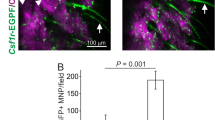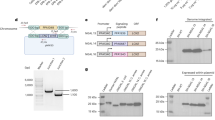Abstract
Biological effects of in vivo transfection of a potential anti-inflammatory gene, designated Sm16, cloned from the human parasite Schistosoma mansoni were analyzed in these studies. A single intradermal injection of a full-length cDNA of Sm16 resulted in the expression of Sm16 in the epidermis, dermis, skin migratory cells and skin-draining lymph nodes of mice for up to 7 days. Subsequently the anti-inflammatory effect of this gene expression was evaluated by inducing an inflammatory response in the skin of mice. These studies showed that Sm16 gene delivery resulted in a significant suppression of cutaneous inflammation as shown by a reduction in cutaneous edema, decrease in neutrophil infiltration, suppression of pro-inflammatory cytokine expression and down-regulation of ICAM-1 expression in the skin inflammatory site. Cells collected from the skin-draining lymph nodes showed reduced proliferation to mitogen. Multiple intradermal injection of Sm16 cDNA failed to induce any antibody response in mice for up to 8 weeks after initial injection. These findings suggest a potential for developing Sm16 gene delivery as a therapeutic agent for treating inflammatory skin disorders.
This is a preview of subscription content, access via your institution
Access options
Subscribe to this journal
Receive 12 print issues and online access
$259.00 per year
only $21.58 per issue
Buy this article
- Purchase on Springer Link
- Instant access to full article PDF
Prices may be subject to local taxes which are calculated during checkout





Similar content being viewed by others
References
Chitsulo L., Engels D., Montresor A., Savioli L. . The global status of Schistosomiasis and its control Acta Tropica 2000 77: 41 41
Ramaswamy K., He Y.X., Salafsky B. . ICAM-1 and iNOS expression increased in the skin of mice after vaccination with gamma-irradiated cercariae of Schistosoma mansoni Exp Parasitol 1997 86: 118 118
Trottein F. et al. Schistosoma mansoni schistosomula reduce E-selectin and VCAM-1 expression in TNF-alpha stimulated lung microvascular endothelial cells by interfering with NF-xB pathway Eur J Immunol 1999 29: 3691 3691
Trottein F. et al. Schistosoma mansoni activates host microvascular endothelial cells to acquire an anti-inflammatory phenotype Infect Immunol 1999 67: 3403 3403
Ramaswamy K. et al. Secretion of an anti-inflammatory, immunomodulatory factor by Schistosomulae of Schistosoma mansoni J Inflamm 1996 46: 13 13
Ramaswamy K., Salafsky B., Lykken M., Shibya T. . Modulation of IL-1α, IL-1β and IL-1RA production in human keratinocytes by schistosomulae of Schistosoma mansoni Immunol Infect Dis 1995 5: 100 100
Ramaswamy K., Salafsky B., Lykken M., Shibya T. . Modulation of IL-1α, IL-1β and IL-1RA production in human keratinocytes by schistosomulae of Schistosoma mansoni
Ramaswamy K et al. Immune evasion by Schistosoma mansoni: characterization of Sm16.8 an anti-inflammatory protein produced by the skin stage schistosomulum. Proc 9th Int Cong Parasitol 1998; 597–603 Mol Biochem Parasitol 2000 108: 101 101
Schratzberger P. et al. Favorable effect of VEGF gene transfer on ischemic peripheral neuropathy Nat Med 2000 6: 379 379
Miller G. et al. Expression of factor VII by muscle cells in vitro and in vivo following direct gene transfer: modelling gene therapy for haemophilia Gene Therapy 1995 2: 736 736
Alila H. et al. Expression of biologically active human insulin-like growth factor-I following intramuscular injection of a formulated plasmid in rats Hum Gene Ther 1997 8: 1785 1785
Hengge U.R. et al. Cytokine gene expression in epidermis with biological effects following injection of naked DNA Nat Genet 1995 10: 161 161
Sawamura D. et al. Induction of keratinocyte proliferation and lymphocytic infiltration by in vivo introduction of the IL-6 gene into keratinocytes and possibility of keratinocyte gene therapy for inflammatory skin diseases using IL-6 mutant genes J Immunol 1998 161: 5633 5633
Meng X. et al. Keratinocyte gene therapy for systemic diseases J Clin Invest 1998 101: 1462 1462
Gollner G.P. et al. Therapeutic application of T cell receptor mimic peptides or cDNA in the treatment of T cell-mediated skin diseases Gene Therapy 2000 7: 1000 1000
Argenbright L.W., Barton R.W. . Interactions of leukocyte integrins with intercellular adhesion molecule 1 in the production of inflammatory vascular injury in vivo. The Shwartzman reaction revisited J Clin Invest 1992 89: 259 259
Udvardi A. et al. Uptake of exogenous DNA via the skin J Mol Med 1999 77: 744 744
Vogel J.C. . A direct in vivo approach for skin gene therapy Proc Assoc Am Phys 1999 111: 190 190
Hengge U.R., Walker P.S., Vogel J.C. . Expression of naked DNA in human, pig, and mouse skin J Clin Invest 1996 97: 2911 2911
Yu W.H. et al. Topical gene delivery to murine skin J Invest Dermatol 1999 112: 370 370
Valle C. et al. Stage-specific expression of a Schistosoma mansoni polypeptide similar to the vertebrate regulatory protein stathmin J Biol Chem 1999 274: 33869 33869
Georgi J. . Schistosoma mansoni: quantification of skin penetration and early migration by differential external radioassay and autoradiography Parasitology 1982 84: 263 263
Richter D., Incani R.N., Harn D.A. . Isotype responses to candidate vaccine antigens in protective sera obtained from mice vaccinated with irradiated cercariae of Schistosoma mansoni Infect Immun 1993 61: 3003 3003
Mercereau-Puijalon O., Fandeur T., Guillotte M., Bonnefoy S. . Parasite features impeding malaria immunity: antigenic diversity, antigenic variation and poor immunogenicity Res Immunol 1991 142: 690 690
Vogel J.C., Walker P.S., Hengge U.R. . Gene therapy for skin diseases Adv Dermatol 1996 11: 383 383
Rio M.D. et al. Nonviral transfer of genes to pig primary keratinocytes. Induction of angiogenesis by composite grafts of modified keratinocytes overexpressing VEGF driven by a keratin promoter Gene Therapy 1999 6: 1734 1734
Watkins C. et al. Analysis of reporter gene expression in ovine dermis and afferent lymph dendritic cells in vitro and in vivo Vet Immunol Immunopathol 1999 72: 125 125
Condon C. et al. DNA-based immunization by in vivo transfection of dendritic cells Nat Med 1996 2: 1122 1122
van Wilsem E.J., Breve J., Kleijmeer M., Kraal G. . Antigen-bearing Langerhans cells in skin draining lymph nodes: phenotype and kinetics of migration J Invest Dermatol 1994 103: 217 217
La Cava A. et al. Cell-mediated DNA transport between distant inflammatory sites following intradermal DNA immunization in the presence of adjuvant J Immunol 2000 164: 1340 1340
Bouloc A. et al. Immunization through dermal delivery of protein-encoding DNA: a role for migratory dendritic cells Eur J Immunol 1999 29: 446 446
Acknowledgements
This work was supported by a grant A139066 from the National Institute of Health (KR). Schistosome life-cycle stages for this work were supplied through NIH-NIAID contract N01-A1-55270.
Author information
Authors and Affiliations
Rights and permissions
About this article
Cite this article
Rao, K., He, YX. & Ramaswamy, K. Suppression of cutaneous inflammation by intradermal gene delivery. Gene Ther 9, 38–45 (2002). https://doi.org/10.1038/sj.gt.3301622
Received:
Accepted:
Published:
Issue Date:
DOI: https://doi.org/10.1038/sj.gt.3301622



